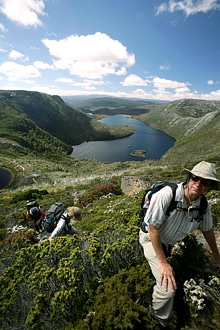Sympathy For The Devil
On any journey, there's always one moment where the place I've traveled to scrubs off its makeup and shows me its true face. Here in Tasmania, this moment comes late on a Wednesday night in a rustic beach shack on the island's northwest coast. The wind is howling. Outside the single window, a wallaby carcass is staked to the ground. Inside, Geoff King – a rancher-turned-naturalist – lets me know our hours-long wait could stretch on for hours more. Suddenly, though, we hear a scramble and a snarl. King draws back the curtain. Peering out with his left eye (he lost the right one years ago), he waves me forward. This may be the encounter I've been waiting for. I'm hoping, of course, to see a devil, of the Tasmanian kind. Because King is a friend of the devil; and a friend of the devil is a friend of mine.
Tasmania, more than most islands, is an unknown quantity. Mention it in conversation, and the reaction is predictable. No one's quite sure what it is (an Australian island state about 125 miles south of the mainland), but everyone's heard of its most famous resident. A week before my flight I asked some friends what they thought a Tasmanian devil was. Their replies could have filled an ark. "A poisonous reptile." "A giant coyote." "It's like an upright lion that spins." That last one sounds familiar. But "Taz" – the voracious, dervish-like creature who tried to make a meal of Bugs Bunny – was dreamed up by Warner Brothers in 1954.
For centuries, the Tasmanian devil has been emblematic of this island. Named by the aboriginals, the shy, nocturnal marsupial, which doesn't appear on the Australian mainland, was once found in every part of "Tassie." During the past 10 years, though, cancer has cut the population by more than half. On November 22, 2007, the devil was listed as an endangered species.
A week after that news, I arrive. My long-anticipated trip to Tasmania started out as a simple exploration of what Australians consider a sort of Lost World, down under Down Under. But now I'm centered on a goal: to find a devil alive in the wild. I'm betting this will happen in Tassie's northwest, a sparsely settled region of dense rainforest and rugged coastlines. But I'm not going to tear up a fast, reckless path to get there, like the cartoon devil.
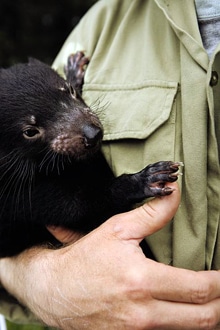
I will let Tasmania take me where it wants me to go. I want that moment, that sight of its true face, to mean something because of the journey. According to the instruments at the Cape Grim Baseline Air Pollution Station, Tasmania has the cleanest air in the world. I feel it as soon as we drive out of Launceston Airport. The atmosphere has a taste here, a silky texture with hints of honey and lavender. I set off with Di Hollister, a Tassie-born guide. She's a compact, vivacious woman who's done a bit of everything: from shucking abalone to teaching in Vietnam. Di provides a running commentary as we drive through a landscape of soft emerald hills. There's a storybook quality to the scene, with its groomed pastures dotted with sheep.
Suddenly, Di brakes, and we creep past some road kill. This one's an echidna, a spiky, egg-laying mammal akin to the platypus. "The fact it's still there," says Di, "shows how few devils there are. In the old days, you couldn't even leave your hiking boots outside your tent. Those devils will eat anything." The devil grabs the headlines, but much of Tasmania's wildlife is just as compelling. The island teems with exotic creatures; it even has the world's biggest earthworms at up to 30 feet long. During the last Ice Age, there were wombats (imagine a huge guinea pig) the size of Mini Coopers. In the early 1800s, the devil's bigger cousin, the Tasmanian tiger, roamed freely with jaws that opened amazingly wide. Bounties and zoos claimed them until they were listed as extinct in 1986. But I'd never heard of the Tasmanian penguin – until I arrived in Stanley.
The town of Stanley sits on a knob-shaped peninsula beneath a massive volcanic plug called The Nut. Grassy terraces separate The Nut from Bass Strait, and the beach is layered with sharp, black rocks. Sightseeing boats often ply these waters for a look at the hundreds of seals that call this place home. But on this night, myriad flashlight beams – filtered with red cellophane – scan the shore, hoping to reveal small, flightless fairy penguins returning from the ocean to find their mates.
"Little penguins are not 'fairy penguins,'" growls Peter, the tank-sized Stanley local guiding our expedition. "They're little penguins." I don't argue.
Twenty years ago there were just a handful of little penguins living along this coast. Habitat destruction, especially around the old stone quarry just below The Nut, had made digging a burrow virtually impossible. Inspired by local innkeepers Graham and Maxine Wells, the residents began helping the birds by hand-building rookeries from the native stones. "From about six pairs when I started," Graham says, "there are at least 80 to 120 pairs now."
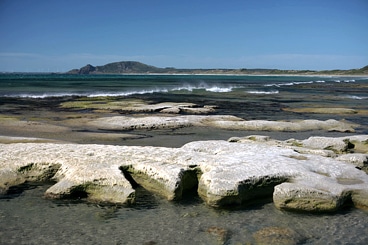
Maybe because of that success story or maybe because they're naturally more docile, I'm able to see penguins much more easily than devils. On this windy night, I soon spot one. Like the devil, it looks like the inspiration for a cartoon. This one isn't much bigger than a fat seagull walking upright. Penguins' eyes are so sensitive that flash photography can blind them. Our red flashlight beams are harmless, but the knee-high birds are aware of us. At one point, half a dozen dodge around my feet. We follow their route into the undergrowth and hear their shrill greeting calls. They head into a nearby graveyard, ironic since these penguins are thriving. They are reclaiming the land. Some are even digging out homes beneath the human graves. "That's not all," Graham says. "They're starting to move into our houses." I hear a very different story about Tasmanian devils as we slice down the island, from Stanley back inland. First Di shows us the lush hills separated by tall stands of gum, pine and myrtle. Kookaburras perch everywhere on the wires. A road sign warns of wombat crossings. "The reason this part of Tasmania is not heavily settled," says Di, "is that it's so densely forested and has heavy rainfall. That worked against sheep grazing. And people settled here after 1877, when the penal colonies were closed. So they had no convict labor to help clear the land."
But as we drive on, that wilderness gives way to denuded hillsides where the rainforest has been clear-cut. It's stark evidence that devils aren't the only local species in danger. Our license plate says, "Tasmania: Your Natural State," but the past few decades have witnessed a battle between those trying to protect Tassie's wild rivers and forests and the powerful companies wrangling for control of these resources.
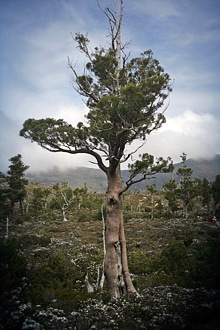
It's such a sensitive issue that one authority I talk to asks to remain anonymous. "The main thing is the forestry issue," he tells me. A pair of billion-dollar corporations, he explains, make huge profits by cutting down the rainforest, planting eucalyptus, then grinding up the trees. "They're selling off our rainforests to Japan," he says, "where the wood chips are used to make boxes." The process is terrifying to anyone who loves wildlife. First, the native rainforest is bulldozed. Then the ground is scourged using napalm. Finally, the area is poisoned with a chemical called 1080, which kills all the herbivores attracted by the young eucalyptus shoots: wallabies, pademelons, possums. As the chemical compound enters the water table and the food chain, its effects spread. The tension between exploitation and conservation is part of Tasmania's history. That's evident at Cradle Mountain, a highlight of the Tasmanian Wilderness World Heritage Area that encapsulates much of this island's wild beauty. This is where glaciers retreated, etching deep lakes and soaring buttes of quartz and dolorite. These formations – along with pink heath, King Billy pine and rainforest – define Cradle.
But when British settlers arrived 200 years ago, the focus shifted more to business than beauty. The island itself was known as Van Diemen's Land, after a British official. The chief surveyor for Van Diemen's Land Company, Henry Hellyer, became the first European to climb to Cradle's 5,000-foot summit, a symbolic moment in 1831. The Europeans largely succeeded in driving out the native Aborigines by then in what's known as the Black War. In the early 20th century, a brighter era began for Cradle. A field naturalist named Gustav Weindorfer stood at the same summit and saw the land much as the Aborigines had. As the story goes, he cried, "This entire area must be preserved for all time, for all people!" Weindorfer, an Austrian who moved to Cradle Valley, spent his life lobbying for Cradle's protection. In 1971, his wish was fulfilled when the area became a national park. It's now treasured, and the famous Overland Track traces its highlights, attracting up to 9,000 hikers a year. I know I owe a debt to Weindorfer as I begin to fall under Cradle's spell. Ben is our lanky, highly animated guide to exploring its natural beauty. Our course at first is less ambitious than the entire 65-kilometer Overland Track, which can take six days to travel. Instead, we start off along the edge of Dove Lake. Looming over the landscape is Cradle Mountain, a soaring reef of rock that looks like the silhouette of a baby in a cradle. One circuit of the lake is about 6 kilometers.
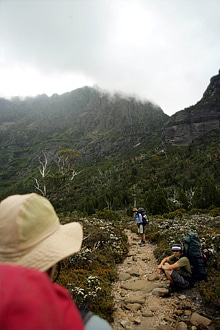
"Kilometers mean nothing in this country," scoffs Ben. "Everything depends on the weather, trail conditions, and if you're in a hurry." We aren't. As we start our walk, both Ben and Liv, his willowy guide-in-training, agree that this is a fantastic year for wildflowers. The flowers of Cradle, blooming in white, red, yellow and orange, are not like the delicate-stemmed poppies of coastal California. They're rough and shrubby with bristly stems and nasty thorns. The plants that took root in Tasmania, I note, are as tough as the people who settled it. We do follow some of the Overland Track, spending several days exploring the craggy range and its landmarks. We go off it to reach Hansons Peak, hauling ourselves up along a loose chain rope. Ben breaks open a box of Tim Tams, Australia's signature snack. The enormous chocolate-covered biscuits look like Kit Kats on steroids. Atop that barren aerie, they taste as good as a truffle. Near Cradle, mists swirl and patches of snow glint like gems against the dark stone. The ground is carpeted with white melaleuca flowers, and strands of waratah, dripping with sweet nectar, add splashes of red to the scene. The earth itself swirls in marble-like patterns, ancient geologies woven through the cliffs and river rocks.
Despite my purist streak, I come to love the raised boardwalk built to protect the fragile ground cover. Made of blonde wood, the path meanders along glacial lakes between moss-covered trees and over fields of buttongrass. It's like the Yellow Brick Road. We spend a night in the Scott-Kilvert Memorial Hut, a big pine room with a coal-burning stove and a sign hammered into the wall: No Nail Boots Upstairs. The hut was built as a shelter after two young hikers died in this capricious wilderness – frozen during a midsummer storm. Our plan is to climb Cradle Mountain. That night, though, foul weather moves in, blanketing the peak with rain and fog. We do make it up to the "cradle" itself and take in a glorious vista of Dove Lake to the north and towering Barn Bluff to the south. As Hellyer and Weindorfer did, I can see the two destinies of the island from even this lower perch. I'm glad, at least for this area if not all of Tasmania, that the guiding vision became Weindorfer's.
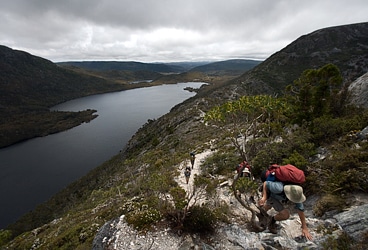
On the final leg of our hike, the lofty ideas become firmly grounded again by a minor obstacle: wombat scat. It litters our nice, neat path. "Wombats find the highest ground and mark it like this," Ben explains. "And here's the amazing part. Their droppings are cube-shaped, so they don't roll away." I look down to examine the scat. It's true. Without thinking, I try to push it away with my foot. It won't budge. For millennia, aboriginal tribes populated Tasmania's west coast, a feral landscape made up of red lichen and quartz boulders. Their grinding stones and kitchen middens still lie among the dunes and grasses. But on this day, as my travels have led me to this coast near the town of Marrawah, I find no Aborigines. In fact, the only sign of any type of human settlement is a single shack, squatting near an outcrop of jagged rocks.
I've left all the guided tours behind to come here. Every time I've pressed someone about my quest to see a devil in the wild, I've heard stories of a man named Geoff King and his own nature preserve. At this isolated place, well, I guess he's my best chance.
Bull kelp and abalone shells crunch under my feet as I hike toward the rustic structure illuminated by the setting sun. The beach is so windy that even the sand has been blown away. The gales and waves hammering this shore have had time to muster their energies; they originated off the coast of Argentina, more than 10,000 miles west. Outside the shack, I see a pickup truck with something tied to the back. I walk closer. At the end of the rope is a mangled wallaby carcass.
King comes out to greet me. The Tassie native is wearing only a T-shirt against the biting wind. Before I ask him about the wallaby, I find out about his place on Tasmania, literally and figuratively. The shack and 860 acres of surrounding land belong to King. Only the shoreline doesn't because it's in an archeological protection zone. Nine years ago, inspired by a wildlife biologist, the former rancher decided to break with family tradition. King relocated his cattle and turned his land into a wildlife preserve.
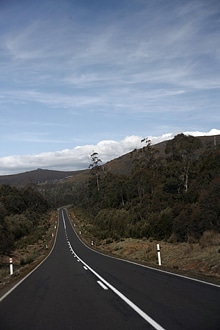
The land has in turn embraced the opportunity. Even a short bush walk provides encounters with ancient aboriginal sites and exotic fauna, hopping wallabies and rotund pademelons (both of which look like small, chubby kangaroos). There are tiger snakes, hawks and eagles, slow-moving wombats and even an elusive platypus. But the creature we've come to see will emerge only at night, when the black sky matches its coat. King began the preparations hours earlier. That flattened wallaby behind his pickup? It's his usual driving-and-dragging method to lay a scent trail. Road kill comes in handy for King. "Devils tend to snuffle along creeks and streams looking for food," he says. "And they use these roadside tracks as well."
Now as I wait in the shelter of the shack, he stakes the wallaby in view of the single window. Portable lights illuminate the macabre scene. We uncork a bottle of Tasmanian chardonnay and wait. As the sky darkens, King explains why devils are endangered. Since the late 1990s, a strange cancer called Devil Facial Tumour Disease (DFTD) has devastated the devils. Oddly, the devils on this side of Tasmania – west of Cradle – seem to have an immunity. "We hope to learn something from these devils that can be used in the fight against DFTD," King says, "and possibly in developing a vaccine." So the tough guy does care, deeply.
A cacophony of snorts and snarls shatters our reverie. King pulls back the curtain. I jump up to join him. There it is: a female devil giving our wallaby the old tooth-and-claw treatment. There's no resemblance to the cartoon character; the real Taz is a stocky, black marsupial the size of a pit bull with a broad head and snubby snout. It's a ravenous scavenger and occasional predator. Distinctive white patches mark its chest.
The aboriginals built a mythology around its markings. The ears turned pink from the native cherry; the white markings came from the clematis flower. The black of its pelt reflects the night, when the solitary creature hunts.
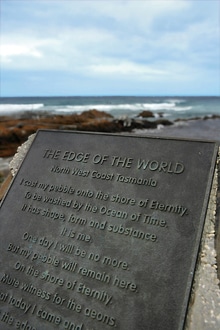
Tasmanian devils, like jackals, aren't the sort of animal to inspire adoration. But the pugnacious creature tearing into the carcass outside King's shack is somehow irresistible. She stops to chew and glances at our window. She can't see us; there's too much glare from the portable lights. At that instant, though, I understand why Tasmanians are drawn to its precarious blend of autonomy and vulnerability. That combination defines many islands – but it's a rare island that has such a perfect mascot.
I catch up with Di again after my encounter with King. "Unless we cure the disease," she says, "devils may be gone from this Earth in 15 years. That's just unthinkable to a Tasmanian."
This is a critical time for all Tassie's residents, not just the devils. How Australia's new government manages the island's rivers and forests will affect -every member of its ecosystem, from the earthworms to the devils to the kangaroos. To visit is to hope for wise choices, for Tasmania is a global treasure. "What I love about this place," Di says, "is that I can be up a mountain in the morning in alpine meadows surrounded by trees and animals you can't find anywhere else – and on an empty beach, swimming, in the afternoon."
I share her passion. Tasmania is under my skin in a way few islands are. I've seen its face. Boarding my flight, I repeat the wish that I cast into the surf on Tasmania's coast, while standing next to a plaque that marked "The Edge of the World." I want to return here one day and have my hiking boots eaten.
